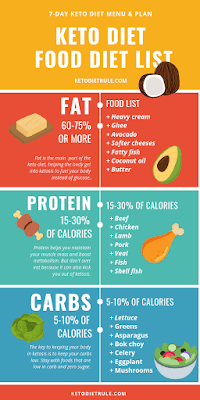Anytime people hear “diet” they assume it is going to be difficult to follow - torturous even. The keto diet has gained tons of popularity because of its benefits for weight loss, blood sugar control, the power to lower disease risk factors, and even preventing muscle loss. As someone who has followed the keto diet for years and reaped the benefits, I often get asked - how do you follow the keto diet?
Once you get the basic rules down - it’s really not hard.
How to follow ketogenic diet? 4 rules for beginners!
Rule #1: Switch Up Your Macros - 75-20-5
The Standard American Diet (SAD) is extremely carb-heavy, and one of the reasons why there are so many health problems that have their roots in eating patterns. The SAD divides its macronutrient contribution as follows:
20-35% calories from fats
10-35% calories come from protein
45-65% calories come from carbs
10-35% calories come from protein
45-65% calories come from carbs
With this diet, we fill our blood with glucose, which is a form of energy that is easy for our body to access. As you probably know, carbs are really easy to overeat - so what we don’t use get stored as fat.
What Can You Eat on a Keto Diet?
To achieve fat loss and several of the other benefits, we need to achieve ketosis. Ketosis is a state where our bodies use ketones from fat instead of glucose for energy.
To do this, we need to switch up our macros.
For a standard ketogenic diet, these are the general macro ratios:
75% calories come from fats
20% calories come from protein
5% calories come from carbs
This is the 75-20-5 rule. For someone on a 2000-calorie diet, this is a maximum of 25 grams of carbs in a day.
Rule #2: Cut out high- and medium-carb foods
Now comes the big question - how do you achieve the 75-20-5 ratio? The first step is to cut out high and medium-carb foods.
These include:
Bread
Tortillas
Snack foods
Potatoes
Corn
Sweet Potatoes
Sweets and candies
Baked goods
High-sugar fruits (like watermelon, pineapple, bananas, plantains, etc..)
Rule #3: Load up on healthy fats
It is really important to eat enough fats on the keto diet so you have enough energy to keep your body healthy and active. Healthy fats include natural saturated fats and monounsaturated fats.
Some foods, especially full-fat dairy and animal protein, are high in healthy (saturated) fats.
Make sure to eat a variety of the following foods in abundance - these should be the central foods of your diet:
Coconut oil
Olive oil (cold pressed)
Avocado
Beef (ideally grass-fed)
Eggs (organic, vegetarian-fed and free range)
Fatty fish (salmon, tuna)
Butter (grass-fed)
Full-fat yogurt
Cheese (full fat)
Avoid processed, unhealthy fats like margarine, and “butter” spread, in addition to foods with trans fats.
 Rule #4: Get enough veggies and low-carb fruits
Rule #4: Get enough veggies and low-carb fruits
Vegetables and low-carb fruits are important to make sure you get the vitamins, minerals, and antioxidants you need to stay healthy.
For veggies, generally choose those that are grown above ground, including:
Leafy greens
Broccoli (essential for dietary fiber)
Zucchini
Bell peppers
Asparagus
Cauliflower (essential for dietary fiber)
Tomato (contains natural sugars so limited consumption)
Celery
Cucumber
Vegetables like peas, green beans, kale, and brussels sprouts are slightly higher in carbs (about 5g a serving) so they should be eaten sparingly.
Low-carb fruits that you can load up on include:
Blueberries
Strawberries
Blackberries
Mulberries
Lemon
Raspberries
Coconuts
Best Keto Diet Guides for Beginners - 7 guides + recipes for 37$
And there you have it! 4 simple rules to follow the keto diet: 75-20-5, avoid high and medium-carb foods, load up on healthy fats, and eat lots of low-carb fruits and vegetables.












0 Comments